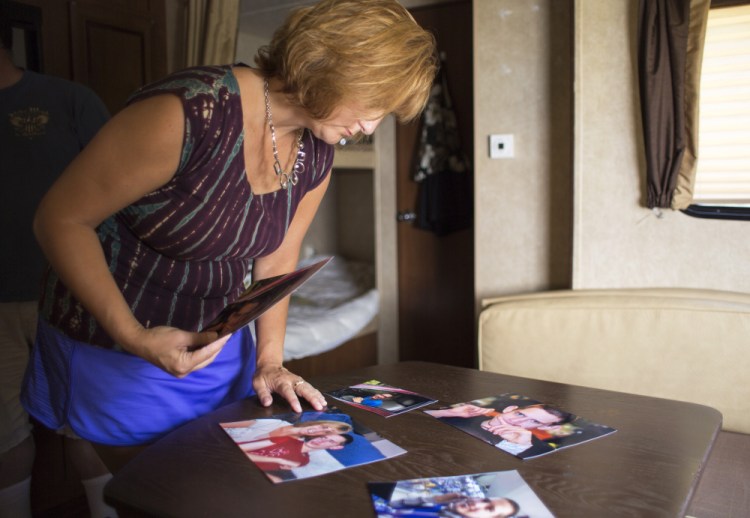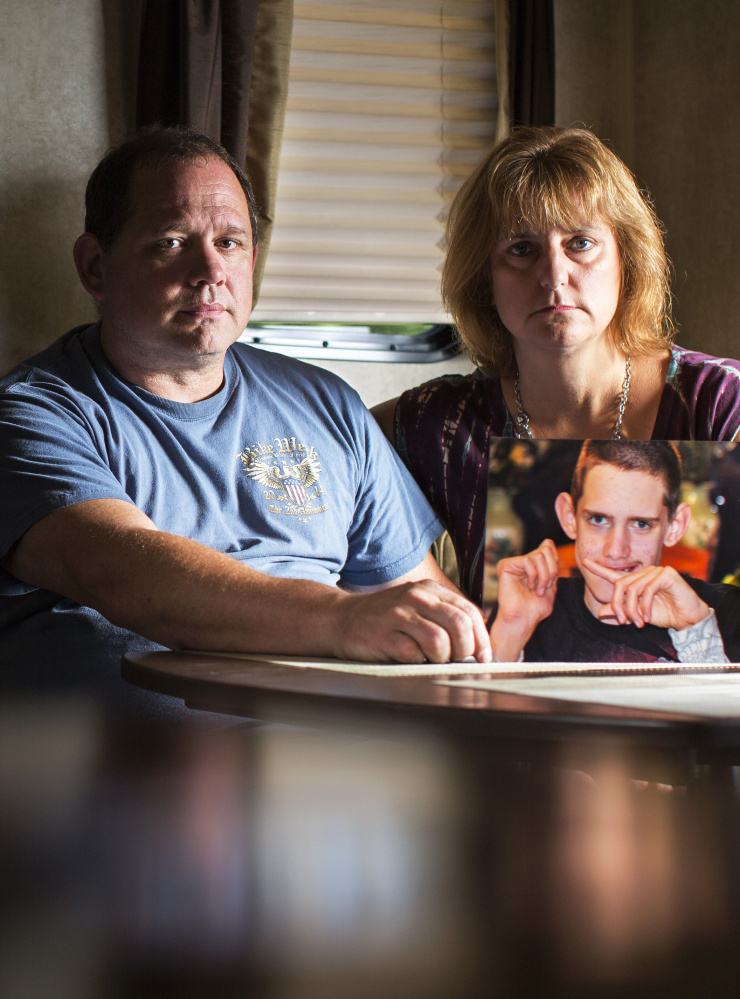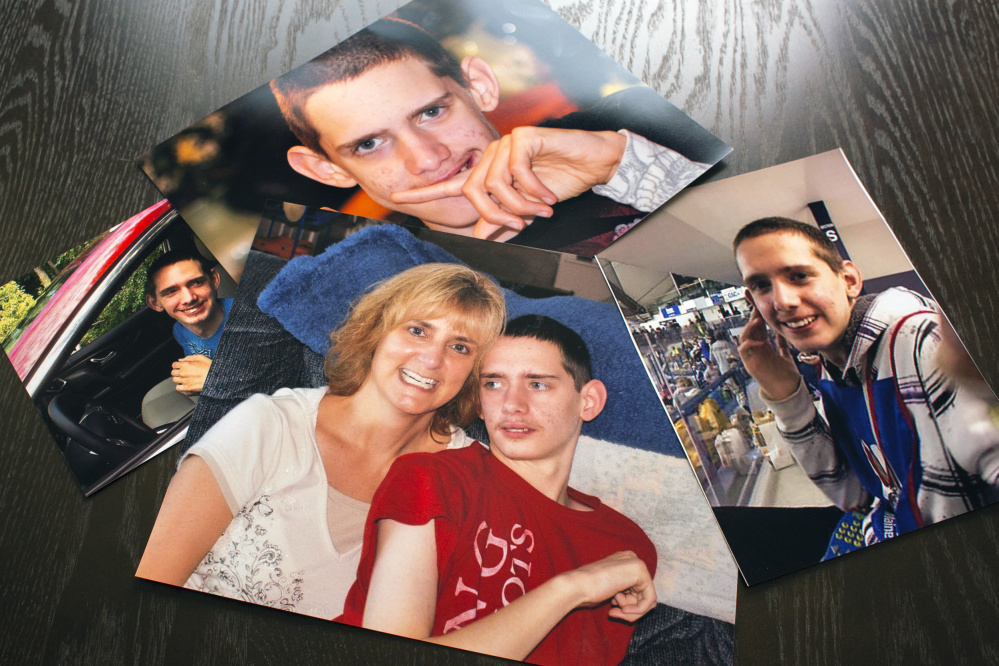Terri Earley had always cared for her nonverbal autistic son at home, but as he got older, she worried about being able to truly take care of him the way he needed.
So about a year ago, 21-year-old Bradley started living in a group home. Six months later – in October – he was found dead in his bed, discovered not by one of the overnight caretakers, but by the manager arriving for work in the morning.
“I wanted him to have a better life. I thought he would be better attended, not less attended,” said Earley, of Topsham. Worse, she still has questions about just what happened. All she has is a death certificate, which says he died of a seizure. But she’s still not sure there was ever an investigation or whether there was any corrective action taken to prevent the same thing happening to someone else.
“I’m not here to say it’s the home’s fault, but I don’t know. It was an unattended death,” she said. “You would have thought there would be some kind of investigation – maybe it was a training issue, or they didn’t follow procedures. He got nothing.”
In fact, there are many laws governing the care of people with developmental disabilities who live with community-based providers. The Maine Department of Health and Human Services has oversight of the very complex system, which includes multiple state agencies, a network of hundreds of providers across the state, formal and informal advocates and the families and clients themselves.
Clients such as Bradley need transportation, help in the workplace and medical care. Funding is a mix of federal and state money, some of it determined by the Legislature and championed or decreased by any given governor, while legal issues can wind up in district attorney’s offices, before family court judges or even the medical examiner. All of it requires clear delineation of duties and responsibilities, and intensive communication.
AUDIT PROMPTS A STRONG RESPONSE
An audit published Aug. 10 by the Office of Inspector General of the U.S. Department of Health and Human Services focused on how the state handled situations where something went wrong for 2,640 adults who receive community-based services under Medicaid. The audit compared hospital emergency room visit data to a state database where providers log all critical incidents – events that rise to the level that they must be reported to the state.
Under the law, each critical incident must be reviewed, and perhaps investigated, starting with the three primary players: DHHS, the providers themselves, and Disability Rights Maine, which has a $330,000 annual contract with the state to be the independent, third-party advocate for clients living with providers.
The audit prompted a strong response from all three players.
DHHS took issue with several of the audit’s findings, adding that the department had already made changes and that the audit represented past practices. Providers, represented by an association, said the root problem was money and that the state needed to increase the providers’ reimbursement rate and fix the system. Disability Rights Maine also pointed to a financial concern – but it thinks the state needs more money, specifically for Adult Protective Services, in order to hire more people and be more active in enforcement.
So how is the system supposed to work when something goes wrong?

It starts with the client and the provider.
There is a list of events that qualify as “critical incidents” or “reportable events” that run the gamut from verbal abuse or a medication issue to sexual abuse or death. Providers must file a report within a day about that incident into a state database maintained and monitored by DHHS. Someone there reviews the incoming incident reports and routes them to the appropriate agency for follow-up.
In cases of possible abuse, neglect, exploitation or a death, the Adult Protective Services unit of DHHS gets involved. If an incident falls into one of the other categories, the providers themselves do an administrative review and report their findings to DHHS within 30 days.
Federal and state regulations define a reportable event or critical incident as “any event that has or may have an adverse impact on the safety, welfare, rights, or dignity of adults with developmental disabilities or autism.”
AUDITORS UNCOVER REPORTING GAP
It all adds up to a huge number of reportable incidents, covering everything from a badly stubbed toe to a death. During the 30-month period – January 2013 through June 2015 – covered by the audit, there were 36,616 critical events reported, or about 40 a day.
Providers, and the auditors, note that many incidents turn out to be relatively minor, and don’t require full investigations. In one case, a client didn’t take a vitamin for three weeks, generating 21 “incidents” even though the vitamin was not medically needed. In the audit, almost a third of the 13,039 medication “critical incident” reports were about patients refusing to take their medication, which the auditors said they didn’t consider potential abuse, neglect or a rights violation.
The audit found that community service providers were not always reporting critical incidents or doing follow-up reviews, and in turn cited DHHS for not properly overseeing the providers.
Auditors uncovered the reporting gap by comparing hospital emergency room visit information with the state database where providers report all critical incidents within a day. The auditors found that, of 2,243 emergency room visits, there were 34 percent, or 769 visits, for which no critical incident reports were submitted to DHHS, cutting off any ability for the state to investigate the circumstances that led to the visits.
Of those 769 unreported incidents, 104 were considered “high-risk,” including head injuries, the auditor said. Providers gave “various reasons, such as staff turnover and clerical errors,” for why they did not always report critical incidents, the auditors wrote.
“We’re dealing with human beings,” said Bonnie-Jean Brooks, chief executive officer of OHI, a provider with services in Hermon and Brewer. During the audit period, her company reported 400 medication issues – but that was out of more than 900,000 medications handed out. As for failing to report incidents, she said caretakers can get busy, or distracted by a more serious situation.
The auditors wrote that DHHS did not give them an explanation for why it did not ensure that providers reported all critical incidents to the database.
FLAWS IN THE REVIEW PROCESS
Each incident that gets reported gets at least an initial review by DHHS.
Officials don’t want providers reviewing themselves on serious incidents, so DHHS is required to investigate all allegations of abuse, neglect, exploitation or deaths within 30 days.
On all other kinds of critical incidents – medication issues, serious injuries, suicidal acts and dangerous situations – the providers do their own, internal, administrative review and file a report with DHHS within 30 days. At that point, DHHS can either accept their report and close the case, or request more information until it is satisfied the situation is resolved.
The auditors found significant problems with the review process: Out of 8,678 critical incidents that required follow-up reviews from providers, DHHS did not have any reviews at all. Providers had done the reviews, but told auditors the state had told them to stop sending them in, a charge the state denied. The auditors said DHHS couldn’t explain why it didn’t notice or take action when providers stopped sending in reviews, or how the state could close the cases without the reviews.
The more serious incident reports submitted to DHHS are sent to the Adult Protective Services unit.
If someone has died, Adult Protective Services reviews the circumstances, and if abuse, neglect or exploitation may have been a factor, it must notify law enforcement. Law enforcement in turn may refer the case to a district attorney or the Maine Attorney General’s State Health Care Crimes Unit. Ultimately, the case is reviewed by the Mortality Review Committee.
If a critical incident involves abuse, neglect or exploitation, it must be referred to Adult Protective Services. That unit, in turn, must report all suspected abuse, neglect or exploitation cases to a district attorney. Once Adult Protective Services completes its own investigation, any evidence that someone was abusing, neglecting or exploiting another person must be reported to a district attorney.
In one case, the auditors found that the state didn’t investigate two independent reports from mandatory reporters that a caretaker was making unwanted sexual advances and physically touching a client, including pulling her onto his lap and rubbing her thigh. The provider told auditors that the client had a “long history of making false accusations,” but the auditors said the state should have immediately investigated the incidents and reported them to a district attorney’s office.
RIGHTS AND RESTRAINTS
Finally, there are two kinds of incidents – restraining a client beyond what is recommended in that person’s individual care plan, and any rights violation – that must be referred to Disability Rights Maine.
If it is a rights violation, Disability Rights Maine must do a preliminary investigation and attempt to contact the client within five days. Sometimes it intervenes with a simple phone call or email to DHHS, sometimes escalating to mediation or requiring a legal remedy. Ultimately, DRM reports the outcome of its actions into the same state database that tracks each incident.
Incidents range from a client being denied access to food or to his or her own money, and could include an objection to not having enough privacy, according to DRM executive director Kim Moody. The agency has stepped in when, for example, a client was being abused by a particular staff person, which led to that staffer being fired.
“We’ve gone in to shared living situations, and found (the client) was doing all the shoveling, all the wood stacking and living in the basement,” Moody said. “The clients we represent are being abused. Our clients are not having good lives.”
The audit found the state wasn’t properly sharing restraint data. However, Moody said that since January, DRM has begun to receive monthly summaries of restraint reports from DHHS.
Ideally, Moody said, no one would ever be restrained beyond what was therapeutically recommended. But DRM has found that clients are routinely restrained by caretakers in community-based settings.
Earley, the mother from Topsham, said she wants the state to improve its oversight of providers, and follow-up on all critical incidents. If the system were working the way it’s supposed to, she’d know what happened to her son, Bradley, and what the state did about it.
“I find it very disturbing that somebody dies and that’s it, and nothing happens. Something obviously needs to change,” said Earley.
“I don’t want his death to be in vain.”
Noel K. Gallagher can be contacted at 791-6387 or at:
Twitter: noelinmaine
Send questions/comments to the editors.






Success. Please wait for the page to reload. If the page does not reload within 5 seconds, please refresh the page.
Enter your email and password to access comments.
Hi, to comment on stories you must . This profile is in addition to your subscription and website login.
Already have a commenting profile? .
Invalid username/password.
Please check your email to confirm and complete your registration.
Only subscribers are eligible to post comments. Please subscribe or login first for digital access. Here’s why.
Use the form below to reset your password. When you've submitted your account email, we will send an email with a reset code.